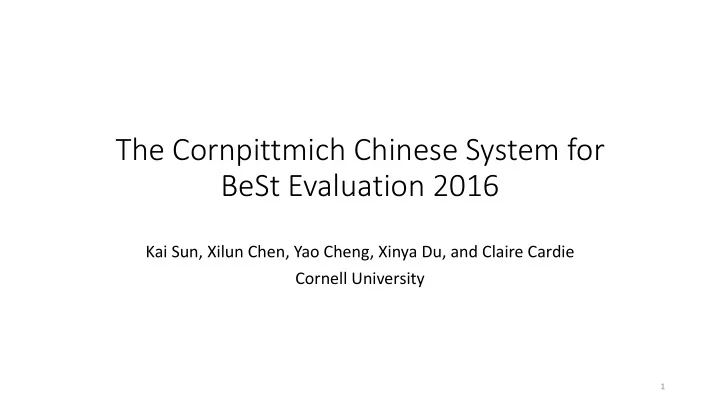

The Cornpittmich Chinese System for BeSt Evaluation 2016 Kai Sun, Xilun Chen, Yao Cheng, Xinya Du, and Claire Cardie Cornell University 1
Overall Approach • For target • Separate components for belief and sentiment • Each is a hybrid system • Rule-based + Machine learning-based • For source • Genre-specific components for both belief and sentiment • Rule-based for both DF and NW 2
Belief 3
Source: Rule-based • Given a target candidate with its mention text/trigger, • For DF, its post author is the source • For NW, if there is a nearby word or phrase denoting reported speech (such as “ 说 ” (“say”), “ 指出 ”(“point out”)) , regard the associated agent and the author of the article as the sources. Otherwise, regard the author of the article as the source 4
Target: Hybrid • Rule-based model • For DF • Always output type=“ cb ” and polarity=“ pos ” for each relation and event • For NW • Output type=“ cb ” and polarity=“ pos ” if the relation/event has only one source, or the source is not the article author • Output type=“rob” and polarity=“ pos ” if the relation/event has two sources, and the source is the article author • A linear model* for filtering • Take in the text around the relation/event mention and decide whether there is a belief or not. If the answer is no, it removes the corresponding belief output by the rule-based model from the final output *We used TextGrocery: https://github.com/2shou/TextGrocery 5
Submissions • DF: Rule + Linear • NW: Rule* System Precision Recall F-score Baseline 0.808 0.877 0.841+ DF Sys1,2,3 0.839 0.842 0.841- Baseline 0.820 0.602 0.694 NW Sys1,2,3 0.583 0.609 0.596 Gold ERE, Test *Linear model was not used because we had no training data for NW 6
Sentiment 7
Source: Rule-based • Same as belief 8
Target: Hybrid Sentence-level Model Pos None Neg ~4K sentences from Softmax Weibo with polarity annotated are used to train the model Average Pooling LSTM Feature 400d word vector trained with posts crawled from Tianya (~4GB) POS tag Word-level sentiments/emotions from 7 dictionaries 9
Target: Hybrid Model for BeSt Pos None Neg Trained with the BeSt data Wrapper High Level Features o Indicators of ERE o Text length o … Sentence Mention Text / Trigger 10
Target: Hybrid Wrapper • A set of data-driven rules with the goal of • Taking advantage of high-level features • Resolving inconsistent predictions from the mention text and the sentence • Setting different acceptance thresholds for different scenarios • Examples • Different thresholds should be set for different types of target 11
Target: Hybrid Wrapper • A set of data-driven rules with the goal of • Taking advantage of high-level features • Resolving inconsistent predictions from the mention text and the sentence • Setting different acceptance thresholds for different scenarios • Examples • Thresholds should be relaxed when the sentence the target entity belongs to has only one entity 12
Target: Hybrid Wrapper • A set of data-driven rules with the goal of • Taking advantage of high-level features • Resolving inconsistent predictions from the mention text and the sentence • Setting different acceptance thresholds for different scenarios • Examples • When the mention text contains words with strong intensity, predictions at the sentence level should be discounted • 把 枉法裁判、胡作非为、违法乱纪的腐败分子 惩处工作抓好 • Make punishing corruption and corrupt elements a success 13
Submissions • We use different 𝐺 𝛾 -score as the System Precision Recall F-score criteria for wrapper training 𝛾 = 1 + 𝛾 2 ⋅ 𝑄 ⋅ 𝑆 Baseline 0.058 0.771 0.108 𝐺 Sys1 0.583 0.303 0.399 𝛾 2 ⋅ 𝑄 + 𝑆 DF Sys2 0.451 0.341 0.388 • DF Sys3 0.600 0.297 0.397 𝛾 2 = 1,2.5,0.2 Baseline 0.011 0.340 0.021 • NW Sys1 0.264 0.052 0.087 𝛾 2 = 2.5, 10, 1 NW Sys2 0.082 0.115 0.096 Sys3 0.298 0.038 0.068 Gold ERE, Test 14
(Possibly) Interesting Observations for Sentiment 15
Choice of Datasets • # of non-none annotations (training corpus) • Annotator thresholds for acceptance are very high compared to most other datasets • An example #Non-none Annotations • 英雄 一路走好!!!!!!!!!!!! English 7234 • ( You are my hero ) May you rest in peace Chinese 554 • Training the sentence-level model with BeSt data yields bad F-score • A simple dictionary-based rule-based system performs relatively well • It outperforms all systems except for ours on Gold-ERE (DF: 0.173, NW: 0.067) • We investigated the use of many datasets and chose the Weibo dataset from NLP&CC 2012. 16
Conclusion • The task is challenging given limited number of annotations • Our hybrid models have relatively good performance by taking advantage of human knowledge (in the hand-crafted rules), internal and external datasets. 17
Conclusion • The task is challenging given limited number of annotations • Our hybrid models have relatively good performance by taking advantage of human knowledge (in the hand-crafted rules), internal and external datasets. Thanks Any questions? 18
Recommend
More recommend